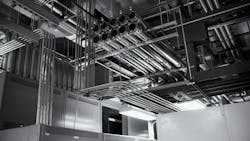Understanding NEC Definitions for Conduit
What is conduit? And would you say this definition from NEC Art. 100 is correct? “An enclosed channel designed expressly for holding wires, cables, or busbars, with additional functions as permitted within this Code.” However, that’s not the definition of “conduit.” In fact, you won’t find “conduit” defined in Art. 100. This definition is actually for raceway.
Conduit is just one “family” of raceway types. You’ll find each of the nine family members defined in Art. 100, and each of them has a Chapter 3 Article with the requirements for using it. Only two of them are metallic: intermediate metal conduit (IMC) and rigid metal conduit (RMC). It’s worth noting that IMC is stronger and lighter than RMC.
Why do these have Chapter 3 Articles? The title of Chapter 3 is Wiring Methods and Materials. Raceway does not have a Chapter 3 Article because it’s not a specific wiring method or material.
Rather than use a generic term such as “conduit” in reference to a particular raceway, it’s better to use the specific name of that particular raceway. So what are the raceway types, and where do you find the requirements for them?
If you go to the Table of Contents of the NEC and look at what’s in Chapter 3, you’ll notice a series of Articles pertaining to specific types of cables. It runs from Art. 315 (MV Cable) through Art. 340 (Type UF). Right after this, the NEC starts with the raceways.
There are four groupings of raceway types:
- Conduits. This series runs from 342 (IMC) through 356 (LFNC).
- Tubing: 358, 360, 362. Those are for FMT, EMT, and ENT, respectively.
- Gutters and buses. This series runs from 366 through 371.
- Miscellaneous. This series covers various types of raceways (e.g., cellular metal floor raceways, strut-type channel raceway, surface metal raceways) and wireways (e.g., metal wireways, nonmetallic wireways). This series runs from 372 through 390, but it’s punctuated with some things that don’t quite belong in this grouping (e.g., nonmetallic extensions, multioutlet assemblies) of raceway types.
As you can see, Articles that cover a specific type of raceway combine to make up most of Chapter 3. The sheer number of them tells you something important. When designing a system, ordering materials, or assembling in the shop or field, you must be specific as to which wiring methods and materials you mean. One way this costs money in the field is when someone is using a bender with a shoe that is meant for a different type of raceway. If the shoe doesn’t say EMT on it, don’t use it with EMT. The same goes for RMC/IMC.
Or suppose you text the shop to deliver a box of “3/4 conduit couplings” to the job site. The next morning, you’re standing there with several sticks of EMT cut and bent, only to find the shop sent you fittings for IMC. Who made the error here? It can easily happen the other way around. You text that you need a box of “3/4 conduit couplings.” The next morning, you’re standing there with several sticks of IMC cut, threaded, and bent. But the box has EMT fittings because the runner didn’t know the difference. There’s no parts bin labeled “conduit couplings” because conduit is a generic term. The box will say IMC couplings or EMT couplings because those are specific names for specific things.
About the Author

Mark Lamendola
Mark is an expert in maintenance management, having racked up an impressive track record during his time working in the field. He also has extensive knowledge of, and practical expertise with, the National Electrical Code (NEC). Through his consulting business, he provides articles and training materials on electrical topics, specializing in making difficult subjects easy to understand and focusing on the practical aspects of electrical work.
Prior to starting his own business, Mark served as the Technical Editor on EC&M for six years, worked three years in nuclear maintenance, six years as a contract project engineer/project manager, three years as a systems engineer, and three years in plant maintenance management.
Mark earned an AAS degree from Rock Valley College, a BSEET from Columbia Pacific University, and an MBA from Lake Erie College. He’s also completed several related certifications over the years and even was formerly licensed as a Master Electrician. He is a Senior Member of the IEEE and past Chairman of the Kansas City Chapters of both the IEEE and the IEEE Computer Society. Mark also served as the program director for, a board member of, and webmaster of, the Midwest Chapter of the 7x24 Exchange. He has also held memberships with the following organizations: NETA, NFPA, International Association of Webmasters, and Institute of Certified Professional Managers.
